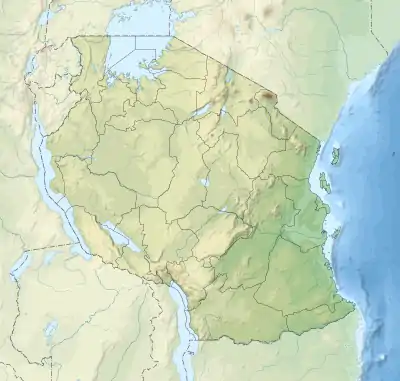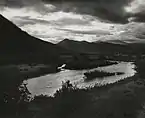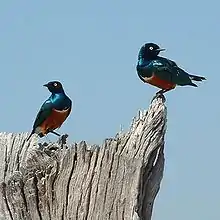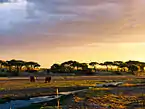Ruaha National Park
Ruaha National Park is a national park in Tanzania. The addition of the Usangu Game Reserve and other important wetlands to the park in 2008 increased its size to about 20,226 km2 (7,809 sq mi), making it the largest protected area in Tanzania and East Africa.[2]
| Ruaha National Park | |
|---|---|
IUCN category II (national park) | |
 | |
 | |
| Location | Tanzania |
| Nearest city | Iringa |
| Coordinates | 7°30′S 35°00′E |
| Area | 20,226 km2 (7,809 sq mi) |
| Established | 1964 |
| Visitors | 21,267 (in 2012[1]) |
| Governing body | Tanzania National Parks Authority |
The park is about 130 kilometres (81 mi) west of Iringa. The park is a part of the 45,000 square kilometres (17,000 sq mi) Rungwa-Kizigo-Muhesi ecosystem,[2] which includes the Rungwa Game Reserve, the Kizigo and Muhesi Game Reserves, and the Mbomipa Wildlife Management Area.[3]
The name of the park is derived from the Great Ruaha River, which flows along its southeastern margin and is the focus for game-viewing. The park can be reached by car on a dirt road from Iringa and there are two airstrips – Msembe airstrip at Msembe (park headquarters), and Jongomeru Airstrip, near the Jongomeru Ranger Post.[2]
History and wildlife
Germany gazetted the Saba Game Reserve in 1910. British colonial authorities changed the name to the Rungwa Game Reserve in 1946.[2] In 1964, the southern portion of the reserve was excised and elevated to full park status.[2]
More than 571 species of birds have been identified in the park. Among the resident species are hornbills.[2] Many migratory birds visit the park.[2]
Other noted animals found in this park are East African cheetah[4] and lion, African leopard and wild dog, spotted hyena, giraffe, hippopotamus, African buffalo, and sable antelope.[2][5]
Since 2005, the protected area is considered a Lion Conservation Unit.[6]
Issues
- The park was formerly known for its large elephant population.[2] It had numbered 34,000 in the Ruaha-Rungwa ecosystem in 2009,[7] before declining to only 15,836, plus or minus 4,759, in 2015.[8]
- In February 2018, the carcasses of 6 lions and 74 vultures were found. They appear to have been poisoned.[9][10]
Gallery
 The Ruaha gorge
The Ruaha gorge The entrance to Ruaha National Park
The entrance to Ruaha National Park The boundary of Ruaha National Park
The boundary of Ruaha National Park A river in Ruaha National Park
A river in Ruaha National Park Superb starling (Lamprotornis superbus)
Superb starling (Lamprotornis superbus) African elephants at dusk in Ruaha National Park
African elephants at dusk in Ruaha National Park
References
- "Tanzania National parks Corporate Information". Tanzania Parks. TANAPA. Archived from the original on 17 September 2008. Retrieved 22 December 2015.
- "Ruaha National Park". Tanzania National Parks. 2012. Archived from the original on 2012-09-29. Retrieved 23 November 2014.
- Mbomipa Wildlife Management Area. Twma.co.tz. Retrieved on 14 September 2016.
- PH (2018-02-23). "Tanzania: 5 Reasons To Visit Ruaha National Park". HowAfrica.com. Retrieved 2018-02-24.
- "Research". Ruaha Carnivore Project. Retrieved 15 March 2017.
- IUCN Cat Specialist Group (2006). Conservation Strategy for the Lion Panthera leo in Eastern and Southern Africa. Pretoria, South Africa: IUCN.
- Karl Mathiesen (2 June 2015). "Tanzania elephant population declined by 60% in five years, census reveals". The Guardian. Retrieved 15 March 2017.
- Adelhelm Meru, Permanent Secretary, Tanzania Ministry of Natural Resources and Tourism (2 November 2015). "Press Release: Ruaha-Rungwa Ecosystem Elephant Census Results, 2015". Retrieved 15 March 2015 – via Tanzania Wildlife Research Institute.CS1 maint: multiple names: authors list (link)
- Kamoga, J. (2018). "East African lions dying of poisoning". The Observer. Retrieved 2018-02-24.
- Winter, S. (2018-02-16). "Lion MASSACRE as six big cats die after eating 'poison'". Daily Express. Retrieved 2018-02-24.
External links
| Wikimedia Commons has media related to Ruaha National Park. |